#donna friedlander
Explore tagged Tumblr posts
Text
Episode 674: When there is a moon
Heiress Carolyn Collins Stoddard is attracted to mysterious drifter Chris Jennings, so much so that she has set Chris up in the caretaker’s cottage on the estate of Collinwood. Today, Carolyn’s friend Donna Friedlander is visiting her. The day’s main action is a classic farce plot. Donna wants Chris to drive her home to Bangor, Maine, but in order to keep a secret from her he makes a series of…

View On WordPress
#amy jennings#barnabas collins#beverly hayes#chris jennings#continuity#dark shadows#don briscoe#donna friedlander#farce#intentional comedy#julia hoffman#new set#visual strategy
2 notes
·
View notes
Text
Episode 674, in which Chris is trying to give Carolyn's pushy acquaintance Donna Friedlander ("She behaves as though we're the best of friends, which we're not") the brush-off.
It's still his time of the month, he's pleading a migraine, and she's not taking the hint. She's also insinuating his cottage is a dump, but I think that's just the setup for the old "All it really needs is a woman's touch" gambit. And the only time that's not obnoxious is when it's being used as lesbian subtext in a Doris Day musical.
Chris, my boy, you need to get more creative with your excuses. Nothing keeps the pushy girls away like a fake case of explosive diarrhea. "I'd love to stay and chat, Donna, but if I don't get to the john right this instant, this living room is going to be a dump in more ways than one, if you know what I mean. Say, did you know that the last guy who lived in this cottage was a murderer?"
P.S. This isn't the first time Barnabas has invited people to an impromptu late-night dinner party. What does he serve? Does he drag Willie out of bed to cook a meal from scratch, or is it just crackers and caviar or fondue or Welsh rarebit or something?
5 notes
·
View notes
Text

Storia Di Musica #312 - Kaki King, Legs To Make Us Longer, 2004
La scoperta di grandi chitarriste arriva oggi ad una delle grandi interpreti attuali. Kaki King era l'unica donna presente in una classifica stilata nel 2006 dalla rivista Rolling Stone, The New Guitar Gods, classifica dove peraltro King è l'artista più giovane in assoluto. Eppure il primo strumento che la giovanissima Kaki amava suonare fu la batteria, da adolescente invece la sua passione si trasferì sulle corde di una chitarra. Inizia a suonare in gruppo con un suo amico di scuola alle superiori, Morgan Jahnig, che diventerà il basista degli Old Crow Medicine Show, un gruppo di Nashville che avrà un forte successo locale negli anni a seguire. Nel 1998 i due amici vanno a New York all'Università, dove Kaki King prende lezioni di chitarra. Per mantenersi, suona da busker nella metropolitana e fa la cameriera in un famoso locale dove si suona dal vivo, il Mercury Lounge.
Kaki riesce a personalizzare a suo modo la tecnica del fingerpicking, che ricordo consiste nel pizzicare le corde della chitarra direttamente con le dite, senza il plettro, che nella sua esecuzione classica prevede la posizione della mano sulle corde vicino al foro della cassa, toccando solo le corde interessate anche se a volte si appoggia il pollice sulle corde per dare più stabilità alla mano. Con piccoli risparmi riesce a registrare un demo di brani strumentali, che impressionano una piccola e giovane etichetta discografica, la Verlour, che nel 2002 le fa firmare il contratto per un disco. L'anno successivo, nel 2003, esce Everybody Loves You: prodotto in prima persona da King, il disco è il primo fulgido esempio della maestria con cui l'artista padroneggia lo strumento. Al fingerpicking che riprende la magia dei giganti americani dello stile, tra cui John Fahey (di cui ho già parlato in questa rubrica), il suo allievo Leo Kottke (dalla vita incredibile e dalla musica inebriante) e Preston Reed (altro campione, che vive in Scozia da venti anni) aggiunge tocchi di flamenco (come la proverbiale tecnica percussiva dello stile andaluso) e addirittura il suonare la chitarra con la tecnica slapping tipica dei bassisti (tecnica che consiste nell'alternare uno slap, cioè uno strappo, e una percussione con il pollice alle corde di uno strumento). Il risultato ammalia la critica, che considera il disco il migliore debutto chitarristi da decenni.
Forte di questo incoraggiamento, Kaki King si mette subito a riscrivere pezzi, e nel 2004 pubblica il disco che ho scelto oggi. La chitarrista passa ad una etichetta di una Major, la Red Ink che fa capo a Epic\Sony Music e in produzione arriva il chitarrista David Torn, uno che ha studiato con Leonard Bernstein, ha suonato con i più grandi artisti del rock, del pop, del jazz, vincendo numerosi Grammy e ha suonato per decine di colonne sonore di film famosi. Il disco, Legs To Make Us Longer, formato da 10 brani strumentali e dal primo esperimento di King al canto, è il tripudio della sua tecnica sorprendente ma piena di sentimento che King ha trasmesso in Everybody Loves You. Ma ci sono anche altre cose in questo lavoro, in primis tocchi di altri strumenti - un contrabbasso, una batteria, accenni di archi in vari punti - che aggiungono più dimensione e consistenza al caratteristico modo di scrivere canzoni di King per chitarra solista. L'impiego di batteria e contrabbasso in Ingots è sorprendente all'inizio, ed è il suo lato spiccatamente melodico che rapisce l'ascoltatore in gemme come Doing The Wrong Thing, dove con King in una danza veloce ma esile attraverso il movimento e lo spazio, si accodano prima il violoncellista Erik Friedlander e la violinista/violista Joyce Hammann entrino nel mix a quattro minuti per portare la melodia nell'etere. King suona per la prima volta su disco la chitarra elettrica in Can The Gwot Save Us?, in uno stile campagnolo e pastorale che, nonostante tutta la sua lentezza ed eleganza, è più misterioso di qualsiasi altra cosa qui. Neanderthal stupisce per la dolcezza, All The Landslides Birds Have Seen Since The Beginning Of The World è misteriosa e quasi gotica, fa impressione la sua capacità di creare emozioni con la tecnica e il suono. La traccia finale dell'album, My Insect Life, la mostra in compagnia di basso, violoncello e batteria, in questa traccia si cimenta per la prima volta al canto, con una voce piccola e "adolescenziale" che è quasi coperta dalla sua chitarra acustica ed elettrica sovraincisa. Due tracce, Frame e Doing The Wrong Thing verranno inserite nella colonna sonora del film Into The Wild di Sean Penn del 2007, con King che insieme a Michael Brook, grandioso musicista e produttore canadese, scrisse i temi principali, accompagnati dalle canzoni che scriverà per la stessa occasione Eddie Vedder (che vincerà il Golden Globe per la miglior canzone originale per Guaranteed). Anche in questo caso, critica entusiasta e un ottimo riscontro di vendite per un disco così particolare. E King aprirà concerti di artisti come David Byrne e collaborerà con i Foo Fighters nel disco Echoes, Silence, Patience & Grace (del 2007) dove suona la sua chitarra magica nel brano Ballad Of The Beaconsfield Miners.
Kaki King dopo questo disco cambierà molto nello stile musicale: paurosa di sentirsi descritta solo come un portento della chitarra acustica, inizierà un percorso più che decennale di studiom che continua ancora oggi, e di sperimentazione sulle potenzialità della chitarra, persino organizzando una sorta di spettacolo multimediale con l'aggiunta di video installazioni, giochi di luce, performace artistiche. Sebbene poco conosciuta, King è un talento eccezionale, una figura iconoclasta che è l'unica nuova voce di quest'epoca alla chitarra acustica, anche se esplora altre avvincenti strade sonore e musicali.
14 notes
·
View notes
Text
When a rich man’s son is kidnapped, he cooperates with the police at first but then tries a unique tactic against the criminals. Credits: TheMovieDb. Film Cast: Tom Mullen: Mel Gibson Katherine Mullen: Rene Russo Det. Jimmy Shaker: Gary Sinise Agent Lonnie Hawkins: Delroy Lindo Maris: Lili Taylor Sean Mullen: Brawley Nolte Clark Barnes: Liev Schreiber Cubby Barnes: Donnie Wahlberg Miles Roberts: Evan Handler Agent Kimba Welch: Nancy Ticotin Agent Jack Sickler: Michael Gaston Agent Paul Rhodes: Kevin Neil McCready David Torres: José Zúñiga Jackie Brown: Dan Hedaya Bob Stone: Allen Bernstein Wallace: Paul Guilfoyle Fatima: Iraida Polanco Roberto: John Ortiz Reporter Guest: A.J. Benza Nelson: Peter Anthony Tambakis Agent Sam: Daniel May Wong News Reporter: Donna Hanover FBI Agent: Anton Evangelista Cop #1: Joe Bacino Cop #2: Carl S. Redding Cop #3: James Georgiades Cop #4: Christian Maelen Cop #5: David Vadim Bank Manager: Michael Countryman Science Fair Coordinator: Cheryl Howard Science Fair Judge: James Ritz Radioman: Craig ‘Radioman’ Castaldo Liquor Store Cop: Joseph Badalucco Jr. Liquor Store Perp: Dell Maara Man at Party: Mike Hodge FBI SWAT Team #1: Mick O’Rourke FBI SWAT Team #2: Henry Kingi Jr. FBI SWAT Team #3: Roy Farfel FBI SWAT Sniper: Lex D. Geddings Don Campbell: Todd Hallowell Film Crew: Director: Ron Howard Screenplay: Richard Price Screenplay: Alexander Ignon Producer: Scott Rudin Original Music Composer: James Horner Director of Photography: Piotr Sobociński Editor: Mike Hill Editor: Daniel P. Hanley Casting: Janet Hirshenson Casting: Jane Jenkins Production Design: Michael Corenblith Art Direction: John Kasarda Costume Design: Rita Ryack Set Decoration: Susan Bode Tyson Second Unit Director: Todd Hallowell Producer: Brian Grazer Stunt Coordinator: Jeff Ward Stunts: Mic Rodgers Stunts: Peter Epstein Stunts: Paul Bucossi Stunts: Gregg Smrz Stunts: Andy Duppin Stunts: Steve Mack Stunts: Don Picard Stunts: Manny Siverio Stunts: Keith Leon Williams Stunts: Elliot Santiago Stunts: Norman Douglass Stunts: Cheryl Wheeler Duncan Stunts: Jophery C. Brown Stunts: Bill Anagnos Stunts: Tim Gallin Stunts: Jim Lovelett Stunts: Janet Paparazzo Stunts: Scott Wilder Stunts: David S. Lomax Pilot: Robert ‘Bobby Z’ Zajonc Pilot: Alan D. Purwin Pilot: Al Cerullo Pilot: Joseph R. Brigham Unit Production Manager: Carl Clifford First Assistant Director: Aldric La’Auli Porter Second Assistant Director: William M. Connor Production Supervisor: Michelle Morrissey Camera Operator: Bruce MacCallum First Assistant Camera: Jay Levy Second Assistant Camera: Christopher Norr Steadicam Operator: Larry McConkey Camera Trainee: Jennifer Stuart Still Photographer: Lorey Sebastian Video Assist Operator: Peter A. Mian Sound Mixer: Danny Michael Boom Operator: Andrew Schmetterling Cableman: Anthony Starbuck Assistant Editor: Guy Barresi Assistant Editor: Richard Friedlander Assistant Editor: Glenn Allen Assistant Editor: Joe Binford Jr. Location Manager: Jan Foster Second Second Assistant Director: Jeffrey T. Bernstein Script Supervisor: Eva Z. Cabrera Production Coordinator: Liz Newman Assistant Production Coordinator: Miriam Schapiro Assistant Production Coordinator: Eric Jacobson Unit Publicist: Julie Kuehndorf Production Accountant: Michael McCormick First Assistant Accountant: Louise DeCordoba Payroll Accountant: Kathy Welch Post Production Accountant: Liz Dykhouse Chief Lighting Technician: Russ Engels Best Boy Electric: Michael F. Burke Electrician: James C. Walsh Electrician: John Smith Electrician: Walter Fricke Jr. Electrician: Robert Connors Electrician: Doug Dalisera Rigging Gaffer: Ken Connors Key Grip: Dennis Gamiello Best Boy Grip: Brian Fitzsimons Dolly Grip: Edward W. Lowry Grip: Michael Finnerty Grip: Martin Lowry Grip: Richard C. Montgomery Jr. Grip: Gerry Lowry Grip: John Ford Rigging Grip: John Lowry Property Master: Tommy Allen Assistant Property Master: Diana Burton Supervising Sound Editor: Anthony J. Ciccolini III Dialogue Editor: Louis Cerborino Dialogue Editor: Bitty O’Sullivan-Smith Dialog...
#baby-snatching#child kidnapping#fbi#hostage#loss of loved one#Millionaire#negotiator#police corruption#ransom#terrorism#Top Rated Movies#yellow press
0 notes
Photo
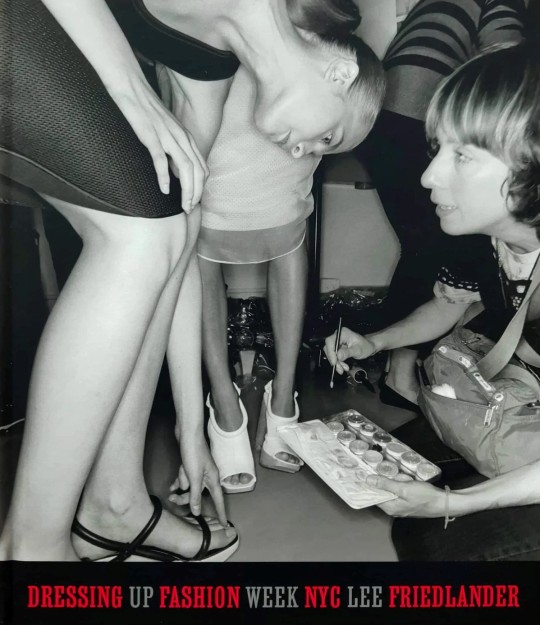


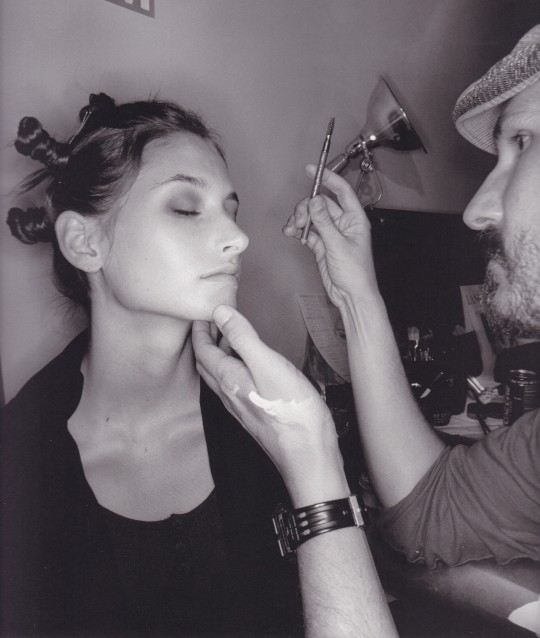
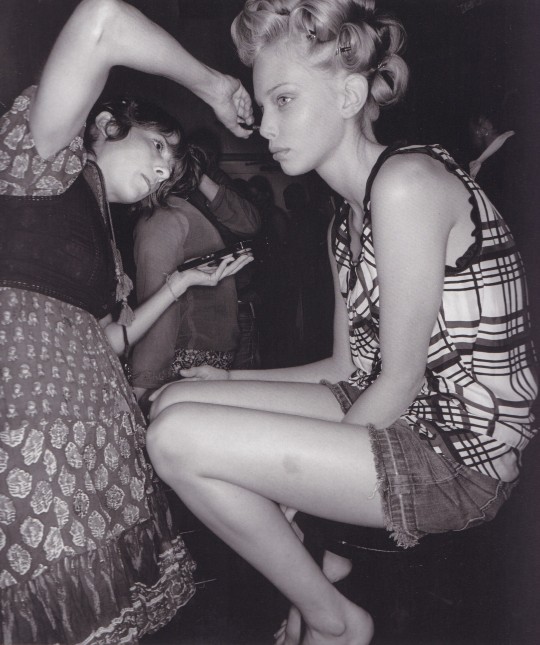

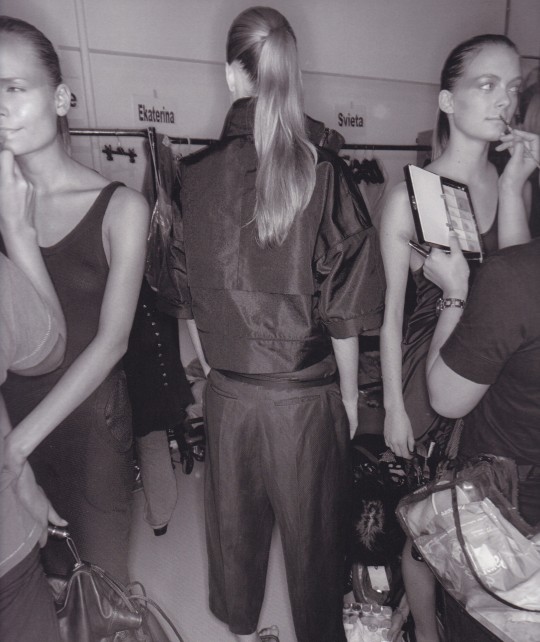


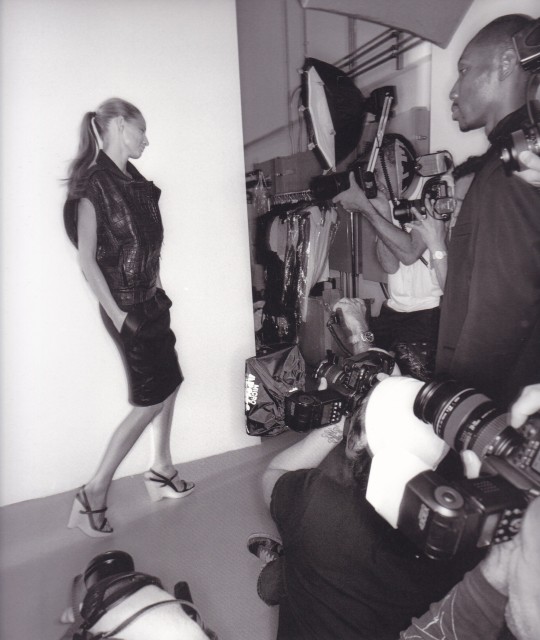
Dressing Up Fashion Week NYC
Lee Friedlander With a conversation between Lee Friedlander and Kathy Ryan
Yale University Art Gallery, New Haven 2015, 59 pages, Hardcover , 28,7 x 33,8 cm., ISBN 978-0-300-17985-9
euro 29,50
email if you want to buy [email protected]
Lee Friedlander (b. 1934) is one of the most renowned photographers of his generation. Through Friedlanders lens, people in their everyday environments are transformed into arresting portraits, and the banal features of roadsides, storefronts, and city streets become vivid scenery. In Dressing Up, Friedlander ventures into new territory, turning his eye to the rarefied world of fashion and revealing precisely what is commonplace about it: behind the glamorous spectacle of the runway are many people hard at work. The photographs, commissioned by the New York Times Magazine, were taken in 2006 during New York Fashion Week, when the artist spent time backstage at the Marc Jacobs, Donna Karan, Calvin Klein, Zac Posen, Oscar de la Renta, and Proenza Schouler shows. The resulting images, many of which are published here for the first time, depict a flurry of toiling stylists, dressers, makeup artists, photographers, and modelsall of them preparing, but not quite prepared, for an image to be taken. Lovers of photography and high-end fashion will be surprised and intrigued by this inside glimpse into the world of runway design.
16/06/22
orders to: [email protected]
ordini a: [email protected]
twitter: @fashionbooksmi
instagram: fashionbooksmilano, designbooksmilano tumblr: fashionbooksmilano, designbooksmilano
#Lee Friedlander#New York Times Magazine#New York Fashion Week 2006#Marc Jacobs#Donna Karan#Calvin Klain#Zac Posen#Oscar de la Renta#Proenza Schouler#dressers#makeup artists#toiling stylists#runway design#photography books#libri di fotografia#fashion books#fashionbooksmilano
27 notes
·
View notes
Photo

[Color photograph: Lighting candles in remembrance at the United States Holocaust Memorial Museum, Washington DC, during Days of Remembrance, 2014. Image via the U.S. Holocaust Memorial Museum.]
January 27th is International Holocaust Remembrance Day. The 20th century has been called “the century of genocide,” but for many, it is specifically the Holocaust--the persecution, imprisonment, and mass-murder of Jews, Romani, sexual minorities, and people with mental, intellectual, and physical disabilities--that first comes to mind when they hear that word. For the average American, certainly, the Holocaust is the touchstone by which genocide is understood. Three-quarters of a century later, it lingers in our collective consciousness. We return to it in film, fiction, scholarship, and personal reflection. Most of us ask ourselves: how could such a thing happen? Why did people allow it to occur? Can it happen again?
Most of us learned about the Holocaust and the events surrounding it only briefly, perhaps in a high school history class. Today we’re presenting a variety of sources that can help readers gain a fuller understanding of how the Holocaust, and other genocides, came to be.
Never Again, Again, Again...: Genocide: Armenia, The Holocaust, Cambodia, Rwanda, Bosnia and Herzegovina, Darfur, by Lane H. Montgomery . Request via OhioLINK. Photographs and text discussing some of the primary genocides of the 20th-21st centuries, many of which are rarely addressed in American K-12 history classes. [Note: There are many books available that discuss these genocides, as well as previous genocides, in greater detail. Although they are too numerous to list here, you are welcome to contact our reference librarians if you’d like help researching any of these topics in greater depth.]
The Routledge History of Genocide; Cathie Carmichael and Richard C. Maguire, editors. Request via OhioLINK. A worldwide history of genocide from the Iron Age to the recent past.
Colonialism and Genocide; A. Dirk Moses and Dan Stone, editors. Request via OhioLINK. Addresses the links between European colonialism and genocide.
Redefining Genocide: Settler Colonialism, Social Death and Ecocide, by Damien Short. Request via OhioLINK. Proposes expanding our understanding of genocide to include systematic methods of population destruction that are less obvious, and more insidious, than mass murder.
Confronting Humanity at Its Worst: Social Psychological Perspectives on Genocide; Leonard S. Newman, editor. E-book. “Explores the psychological and emotional predispositions for extreme intergroup violence, the genocidal mindset, and the roles of obedience and social influence.” --from publisher
Economic Aspects of Genocides, Other Mass Atrocities, and Their Preventions; Charles H. Anderton and Jurgen Brauer, editors. E-book. “Demonstrates theoretically, empirically, and with case study evidence how microeconomic incentives (e.g., looting opportunities, survival motivations) and macroeconomic environments (e.g., low growth, negative economic shocks) can dramatically affect genocide risk and prevention.” --from publisher
The Origins of Nazi Genocide: From Euthanasia to the Final Solution, by Henry Friedlander. E-book. Examines the often-overlooked Nazi atrocities towards disabled people, and how the segregation and mass murder of disabled people normalized such policies towards ethnic minorities in Nazi Germany.
Forgotten Crimes: The Holocaust and People with Disabilities, by Suzanne E. Evans. Request via OhioLINK. Explores the Nazi atrocities towards disabled people; interviews with disabled Holocaust survivors.
Deaf People in Hitler's Europe; Donna F. Ryan and John S. Schuchman, editors. CS Library 3rd floor, 940.5318 D2786.
Women in the Holocaust: A Feminist History, by Zoë Waxman. E-book. Focuses on gender roles and the narratives of women during the Holocaust.
The Holocaust in Romania: The Destruction of Jews and Gypsies Under the Antonescu Regime, 1940-1944, by Radu Ioanid. CS Library 3rd floor, 940.5318 I641h. Details anti-Semitic and anti-Romani violence in Romania during World War II.
Antisemitism Before and Since the Holocaust: Altered Contexts and Recent Perspectives; Anthony McElligott, Jeffrey Herf, editors. E-book. Discusses the contemporary conspiracy theories of Holocaust denialism and their cultural/political roots.
The Holocaust: A German Historian Examines the Genocide, by Wolfgang Benz. CS Library 3rd floor, 940.5318 B479h. Details the gradual process by which anti-Semitism became normalized as a political policy in Nazi Germany, culminating in mass murder.
The Nazi Conscience, by Claudia Koonz. Request via OhioLINK. Explores the systematic process by which ordinary Germans were carefully inculcated with nationalist, white-supremacist ideals, culminating in the normalization of violence towards certain populations.
19 notes
·
View notes
Text
No, non è la Vivian Maier russa
di Carlo Maccà
-- C'era da aspettarselo. Dopo il fortunoso ritrovamento della Valigia Messicana con gli originali delle foto di Robert Capa, Jim Seymour e Gerda Taro (povera ragazza! vittima due volte: delle bombe dell'armata franchista e della pluripremiata fantabiografia d'una scrittrice che di fotografia non ne capiva una beata favola, volume presto ospite del mio cestino), e dopo il fortunato acquisto e disvelamento del baule di Vivian Maier (anch'essa oggetto di una biografia finta alla quale, vista la precedente esperienza, mi mancò l'ardire di accostarmi), c'era da aspettarsi che altri "inattesi" tesori venissero più o meno (ma sempre!) avventurosamente recuperati e poi offerti all'ammirazione del pubblico.
Non si vuole negare che possano esistere autori di corpus fotografici meritevoli d'essere scoperti o riscoperti. Quello che è avvenuto di recente per Gerda e Vivian, si era già prodotto in passato: si pensi, tanto per fare degli esempi, alle lastre fotografiche di Bellocq salvate da Lee Friedlander, all'Atget parigino valorizzato solo in fin di vita ma soprattutto dopo la morte da Berenice Abbott. Metterei nel numero anche Lartigue, che solo vicino ai settant'anni cominciò lui stesso a rivelare la stupefacente produzione fotografica della propria infanzia e adolescenza.
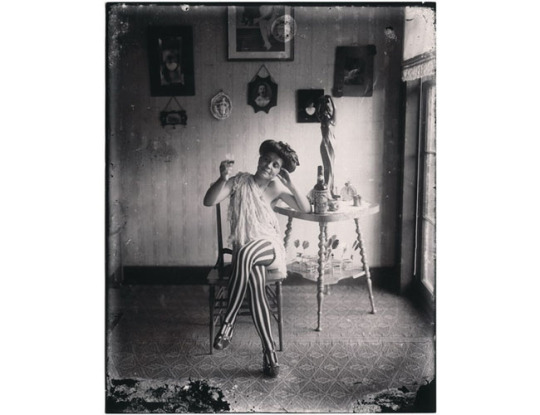
E. J. Bellocq, da Storyville Portraits, c.a 1912.
Da un paio d'anni, con crescente frequenza, un altro baule sta riversando su tutti i media cartacei e virtuali, come dentro a sale d'esposizione in giro per l'Europa, il contenuto fotografico d'un baule russo. Niente d'illegale, niente d'illecito, nessun contrabbando. C'è solo vedere se il materiale merita veramente l'enfasi con cui viene presentato. Per esempio, Rassegna stampa/web di fotografia del mese di Dicembre 2019 curata dalla Redazione di Fotopadova riprendeva da http://www.artslife.com uno scritto di Massimo Mattioli dal titolo "La Vivian Maier russa. Esplode il caso di Masha Ivashintsova, grande fotografa scoperta dopo la morte". Un articolo su Il Fatto Quotidiano del 30 dicembre scorso enfatizzava in un'intera pagina il "Talento Svelato" di Masha: L'Unione Sovietica nascosta negli scatti di una donna - cautamente e saggiamente evitando ogni riferimento alla Maier. Costei invece era tirata in ballo fin dai titoli da innumerevoli siti di attualità d'arte e di fotografia italiani e stranieri che, in massa, si occuparono della miracolosa scoperta:
Masha Ivashintsova la Vivian Maier russa scoperta nel 2017
Masha Ivashintsova, una nuova Vivian Maier?
Masha Ivashintsova and the Discovery of the "Russian Vivian Maier"
https://www.darlin.it/inspiration/gli-splendidi-scatti-ritrovati-della-vivian-maier-russa/2/
https://www.artuu.it/2018/03/27/scoperta-la-vivian-maier-russa/curiosita/
https://cameranation.it/masha-ivashintsova-la-fotografa-ritrovata-come-vivian-maier-ma-in-russia/
Altri:
www.mardeisargassi.it/masha-ivashintsova-la-fotografa-ritrovata
https://www.internazionale.it/foto/2018/07/10/masha-ivashintsova-foto
il confronto lo fanno nel testo. E nemmeno il profilo della Russa in Wikipedia può esimersi di citare la bambinaia fotografa Franco-Americana.

Masha Ivashintsova,Tbilisi, Georgian SSR, 1989 vs. Vivian Maier
Soltanto un titolo è fuori dal coro; Masha Ivashintsova, non è la nuova Vivian Maier. (www.pmstudionews.com › NEWS › NEWS ultimissime!) [il grassetto è nostro] ma il testo si limita a ripetere la negazione: " Nuova Vivian Maier? Non proprio" [il grassetto è nell'originale] senza giustificarla criticamente, accontentandosi di descrivere le condizioni politiche, sociali e culturali nelle quali Masha fotografava segretamente: che fossero totalmente diverse da quelle in cui la Maier viveva e che catturava, e involontariamente "immortalava", è fin troppo banale.
Banale è pure il fatto che la vicenda della Maier non venga mai apertamente citata in tutte le operazioni di Asya Melkumyan ai fini della promozione dell'opera della madre Masha Ivashintsova. Ciò non basta a evitare il sospetto che si tratti d'una operazione accuratamente pilotata a imitazione del fenomeno americano: la valigia dimenticata, il ritrovamento casuale, le fotografie mai mostrate a nessuno (non soltanto mai messe in mostra), i molti negativi non sviluppati ... In rete era stato postato perfino un filmato che ricostruiva la scoperta: la scaletta appoggiata al soppalco, la salita, l'estrazione della valigia attraverso la porticina, l'apertura del tesoro ... Molte delle fotografie presentate nel sito ufficiale (www.mashaivashintsova.com) includono nell'inquadratura anche i fori di trascinamento della pellicola 135, forse da intendere come certificazione di autenticità: DOCG, immagine come è uscita dal negativo ritrovato e mai stampata, e forse neppure sviluppata, dall'autrice?

Masha Ivashintsova, 1° Maggio, Leningrado, USSR, 1974, vs. Vivian Maier (1972?)
Ma il nodo principale della questione è: il richiamo a Vivian Maier avrebbe un significato sostanziale, oltre che episodico? significherebbe un approccio simile alla materia fotografata nella scelta dei soggetti e nel sentire nei loro riguardi - che è quello che conta? E qui non ci siamo. Manca del tutto in Masha lo sguardo pungente verso l'ambiente - soprattutto la strada -, la gente e la società russe, quello sguardo con cui la bambinaia franco-americana penetra la città in cui vive e i suoi abitanti, e spesso bersaglia con palese ironia. Sguardo che avvicina Vivian Maier allo zurighese Robert Frank (più che a Lisette Model, Diane Arbus, Walker Evans e ad altri citati da Geoff Dyer nella prefazione al primo - 2011 - dei numerosi libri a lei dedicati), come se quel tipo di sguardo fosse una peculiarità di osservatori che vengono dal di fuori.

Vivian Maier, New York, vs. Robert Frank, Prima cinematografica, Hollywood
Infatti, seppure newyorkese di nascita, ma di padre austriaco presto sparito all'orizzonte e di madre immigrata dalla Francia, Vivian aveva passato i suoi anni più formativi in Francia, assieme alla madre ritornata temporaneamente al paesello natio. Quando rientrò nella Grande Mela, poteva già guardarsi attorno con occhio disincantato. E, colla maturità, trovare un prodigioso equilibrio formale fra quello che vedeva con quell'occhio e valutava colla mente, e quello che inquadrava attraverso l'obiettivo e fissava sulla pellicola. O probabilmente già le rimaneva composto nella mente, tanto che non occorreva neppure che controllasse materialmente il risultato attraverso la stampa.

Robert Frank (Salone d'albergo - Miami Beach) vs Vivian Maier
Nulla a che fare coll'occhio bonario con cui la russa guardava la città, i passanti, i bambini, gli amici, gli amanti. E che fissava sulla pellicola con esiti livello amatoriale, seppure ottimo, ma non distinto da un particolare carattere personale.
La Maier è stata giustamente celebrata fin dalla prima uscita come fotografa di strada: Vivian Maier - Street Photographer è il titolo del libro con cui John Maloof la presentò al mondo anglosassone. La sua è fotografia di strada in tutti i sensi: come ambiente, come approccio pratico e come spirito. Perché non diventa street photography ogni fotografia fatta in istrada (mentre sono ormai accettate come tali immagini in ambienti differenti ma risultanti da un identico approccio fattuale e concettuale), ed è difficile trovare fotografie scattate da Masha in piazze o strade che appartengano pienamente e consapevolmente a tale categoria.
Quanto alla Maier, sarebbe importante sapere se il famoso cassone acquistato da Maloof contenesse anche il resto dell'archivio - libri, riviste e giornali - e se fra questo ci fosse materiale attinente alla fotografia. E se vi comparisse in qualche modo anche Ben Shahn, pittore molto in voga a quell'epoca, e fotografo da considerare il vero iniziatore della street photography in senso stretto (https://www.fotopadova.org/post/166879545573). Immigrato dalla Lituania da bambino assieme ai genitori ebrei, fu anch'egli capace di osservare la società e la cultura statunitense con un atteggiamento definibile come "partecipato distacco".
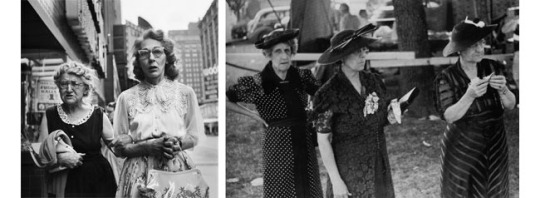
Vivian Maier vs Ben Shahn, July 4 Celebration, Ashville, Ohio, 1938.
Se proprio si vuole cercare un punto di contatto fra le personalità di Masha e di Vivian, lo si potrebbe trovare nel ricorso compulsivo all'autoritratto, sia diretto di fronte all'obiettivo, sia indiretto negli specchi e nelle vetrine. Ma questo riguarda un ambito che concerne il rapporto con il sè, piuttosto che con l'altro. Da affidare agli psicologi studiosi del dilagante fenomeno del selfie, piuttosto che alla critica fotografica.
Altri "fortunati ritrovamenti" di valigie, bauli, casse, cassette e cassettine, borse, buste, magari anche sacchi e zaini, si sono susseguiti dal Veneto al Molise, dall'Essex alla Moldavia, e probabilmente da una parte all'altra del mondo. Generalmente si tratta di depositi dimenticati di prodotti di professionisti o mestieranti di provincia, che possono interessare tutt'al più per la cronaca (non la Storia) del luogo e dei suoi abitanti. Oggetti nel migliore dei casi validi per manifestazioni e archivi locali, anche quando sono stati esaltati dai sagaci scopritori e dai loro eventuali esegeti come opere memorabili o finanche capolavori. Fra i loro sconosciuti o dimenticati autori, nessun Malik Sidibé.
Chi volesse portare avanti iniziative che possano valere come scoperte, dovrebbe piuttosto dedicarsi a recuperare e a riproporre l'opera di fotografi di grande valore del passato anche recente, che hanno dato un contributo originale all'avanzamento della fotografia nell'ambiente culturale in cui hanno lavorato, ma che inopinatamente sono passati nel dimenticatoio. Con Fotopadova si tenta di recuperare alla notorietà, nel ricordo delle opere di grande impatto esposte in varie occasioni a Padova attorno agli anni '60, il toscano Paolo Pellegrineschi, grande fotografo e maestro d'una generazione di fotografi toscani. La rete conserva solo rarissime, puramente casuali, tracce suo nome e si i ringrazia Libero Musetti per le presenti e future informazioni sull'autore che considera il proprio Maestro, e chiunque altro voglia contribuire con notizie e materiale in proprio possesso.
Oltre alle poche (5) immagini conservate nell’archivio 3M perché pubblicate nella Rivista Ferrania dal 1959 al 1965, altri documenti si dovranno cercare nelle riviste Tutti Fotografi e Popular Photography di quei decenni; introvabili finora i suoi tre libri sul ritratto fotografico, sul trattamento del negativo e sull’ingrandimento fotografico, che dovrebbero essere illustrati a titolo di esempio, da sue opere.
----------------------------
Le immagini sono state ricavate, per finalità di diffusione culturale, dalle seguenti fonti:
Masha Ivashintsova: www.mashaivashintsova.com
Vivian Maier: Vivian Maier Fotografa, GEDI 2017
Robert Frank: Gli Americani, Contrasto 2008
Ben Shahn: Ben Shahn Photographer, Da Capo Press, 1973
E. J. Bellocq: Wikimedia Commons.
#Valigia messicana#Vivian Maier#Bellocq#Eugene Atget#Jacques-Henri Lartigue#Masha Ivashintsova#Massimo Mattioli#Asya Melkumyan#Robert Frank#Geoff Dyer#John Maloof#Ben Shahan#Paolo A.Pellegrineschi#Rivista Ferrania#Tutti Fotografi#Popular Photography#Libero Musetti#Carlo Maccà
1 note
·
View note
Text
Thoughts : The Killing of a Chinese Bookie (1976)

After a trio of very personal, critically acclaimed independent films, John Cassavettes attempted to acquiesce to the popular sway with a deceptive passion project in the form of The Killing of a Chinese Bookie. While being a memorable and entertaining film, it was also one that became the bane of Cassavettes' personal and creative experience, resulting in a pair of releases years apart from one another that reflect the independent vision versus the influence of the money men. The film has always fascinated me as much as it has entertained me, and after a recent revisit, I felt the need to share my thoughts on it, as Cassavettes inspires me heavily.
Cosmo Vittelli (Ben Gazzara) is the owner of Crazy Horse West, a strip club located on the famous Sunset Strip in Los Angeles. Cosmo not only runs the business aspects of the club, but he is hands on in nearly all aspects of the operation, including designing and choreography of the dancers’ performances. As a self-proclaimed man of ‘style’, Cosmo longs for a chance to run a clean business where his art is appreciated at something more than a carnal level. After paying off a gambling debt to local loan shark Marty (Al Ruban), Cosmo meets Mort (Seymour Cassel), a gangster who runs a gambling hall with is associates. Cosmo talks himself into an invite, and after picking up three of his dancers, he visits Mort’s establishment, where he promptly racks up another sizeable debt to the gangsters. The following night, Mort brings his associates to Crazy Horse West and make a power move : hand over the Crazy Horse West, or kill a heavily-guarded bookie named Harold Ling (Soto Joe Hugh), who turns out to be Benny Wu, a formidable leader in the Chinese gambling world. With the biggest decision of his life in front of him, and pressure coming from Mort and his associates, Cosmo must put his integrity and morals to the test, once and for all.
Having a character like Cosmo (who longs in the deepest recesses of his heart to be an accomplished artist respected for his ‘style’) wishboned between the worlds of cabaret workers and gangsters makes for an interesting perspective on standard elements of vice and danger. Cosmo is very human in the sense that, although his intentions are lofty and dignified, his actions are often ham-handed, ill-thought out and poorly executed, save for when his life is on the line. It’s actually these moments when Cosmo’s back is against the wall that he actually lives up to the character qualities he aspires for, as if normal life or standard level inspiration gives him an excuse to phone in his actions. Ultimately, Cosmo is the true antagonist to his role as protagonist, as the majority of his issues have a straight line of responsibility connected to them that one can trace right back to Cosmo himself.
Outside of its neo-noir narrative, the film plays as a metaphor for John Cassavettes’ views on, and experiences in, Hollywood and the film industry. Crazy Horse West symbolizes Cassavettes and his company of actors, with each of their performances representing the work they release independently and outside of the system. Mort and the gangsters represent outside monetary and production influences, dead set on exerting their power and will come hell or high water. All of the narrative tension and conflict in the film are allegories for the endless problems and stress that come with the labor of love that is filmmaking. The lengths that Cosmo goes through to protect Crazy Horse West and those connected, even at a detriment to himself, represent the insane amounts (and levels) of choices and hurdles often placed at the feet of a director during a production, be it independent or otherwise. Even Cosmo’s brief trist that betrays the trust of Rachel directly after his gambling pitfall symbolizes the unhealthy way that creatives sometimes attempt to use work as a way to avoid their real stress, pain and problems.
The Killing of a Chinese Bookie, in my opinion, serves as the first major jump in the Cassavettes independent canon in terms of production level... as much as I love Shadows, Faces and A Woman Under the Influence, this film is the first one to resemble its peers. This aesthetic, however, does not take away from the Cassavettes technique, as the lighting still has an edge to it, and the camera is much more introspective in its observation as opposed to the standard Hollywood style of framing. The patience that Cassavettes allows his tension-filled moments, be it the original or the truncated cut, holds well on the screen, and gives the audience a true interpretation of what Cosmo is going through mentally. For such a simple narrative, it’s impressive how much of a character study that Cassavettes was able to shape out of the project.
Ben Gazzara holds the weight of the film surprisingly well, managing to look both oafish and classy with an almost effortless manner of swinging between the two states. This plays well against Seymour Cassel’s sharp, slick manner, as if he is always angling, and Cosmo just happens to be the sucker born at that particular minute. Meade Roberts and his wonderfully dismissive attitude pop as Mr. Sophistication, with his closing moments between a wonderfully punctuating button to end the ride that is The Killing of a Chinese Bookie. Timothy Carey, Robert Phillips and Morgan Woodard are wonderfully intimidating, tiptoeing the line between caricature and tough guy. Azizi Johari, Virginia Carrington, Alice Friedland, Donna Marie Gordon and Carol Warden bring charm and personality to their roles as staff of Crazy Horse West, especially when a few of them are given a chance to double-down on the personality aspect once allowed into the bigger world by the Cosmo character. Appearances by Haji, Derna Wong Davis, Kathalania Veniero, Val Avery, John Finnegan and a very sobering moment by Soto Joe Hugh round out the cast.
Plain and simple, this film is chock-full of actors that I love, and its off-beat approach to a genre I love makes it a refreshing view despite how often its watched or how recent the last viewing is. While not my favorite of the independent Cassavettes canon, I find it the one that I rewatch the most, and the one that impresses me the most in terms of production value balanced against narrative value.
#ChiefDoomsday#DOOMonFILM#JohnCassavettes#TheKillingOfAChineseBookie#BenGazzara#TimothyCarey#SeymourCassel#MorganWoodard#AziziJohari#RobertPhilips#MeadeRoberts#JohnRedKullers#AlRuban#VirginiaCarrington#AliceFriedland#DonnaMarieGordon#Haji#CarolWarren#DernaWongDavis#KathalinaVeniero#ValAvery#SotoJoeHugh#JohnFinnegan#JamesLew
2 notes
·
View notes
Note
Pass the happy! 🌻🌈 When you receive this list 5 things that make you happy and send this to 10 of the last people in your notifications
Geez this was going to sound like a Hallmark card and you’d hate me for it so I’m changing and offer this:
The work of Frank Lloyd Wright, Philip Johnson, Mies Van Der Rohe, Walter Gropius, Pablo Picasso, John Singer Sargent, John Singleton Copley, Tim Page, Hunter Thompson, Charles Bulfinch, Richard Nuetra, Louis Kahn, Rembrandt , Juan Gris, Basquiat, Keith Haring, Roy Lichtenstein, William Eggleston, Lee Friedlander, Andy Warhol, Wagner, Monet, Tchaikovsky, Mozart, Herbie Hancock, Miles Davis, Miles Davis, Miles Davis, Chet Baker, Duke Ellington, Frank Sinatra, Ella Fitzgerald, Johnny Hartman, Alex Chilton, Weegee, John Waters, Little Walter, Little Jimmy Scott, Pete Townshend, Billy Wilder, Ernst Lubitsch, Martin Scorsese , Francis Coppola, Bryan Ferry, David Bowie, David Bowie, David Bowie, David Bowie, Roger Keith Barrett, Townes Van Zandt, Stevie Van Zandt, Jimmy Gandolfini, Keith Jarrett, Chick Corea, Jeff Beck, Walter Becker, Donald Fagen, Jimmy Page, Jimmy Page, Jimmy Page, F. Scott Fitzgerald, Walker Percy, Tennessee Williams, William Faulkner, Nick Cave, Nick Drake, Nick Kent, Brian Wilson, Iggy Pop, Roger Waters, Steve Marriott, Gram Parsons, Mac Rebbenack, Erick Purkhiser, Kristy Wallace, Steve Earl, Lou Reed, Lou Reed, Lou Reed, Leonard Cohen, Dean Wareham, Joe Strummer, Bruce Springsteen, John Lydon, Siouxsie Sue, Otis Redding, Isaac Hayes, Sly Stone, Sly Stone, Sly Stone, George Clinton, Al Green, Chuck D, Professor Griff, Terminator X, Flava Flav, The RZA, ODB, Kraftwerk, Joy Division, New Order, Depeche, Monkees, Doc Pomus, Van Morrison, Lee Perry, Phil & Don, The Move, Cheap Trick, Redd Kross, X, The Turtles, Jan & Dean, Link Wray, Little Richard, Little Richard, Little Richard, Larry Williams, Eno, Japan, Ennio Morricone, St. Etienne, Fountains of Wayne, Ivy, Blossom Dearie, Julie London, The Stylistics, The Trammps, The Delfonics, The Supremes, The Temptations, Marvin Gaye, Marvin Gaye, Chris Stamey, Peter Holsapple, Chris Bell, Kenn Kweder, The New York Dolls, Robert Quine, Chuck Berry, Bo Diddley,Richard Hell, Richard Lloyd, Billie Holiday, Ray Charles, Beatles, Beatles, Beatles, Kinks, Kinks, Donna Summer, Ike and Tina, Black Uhuru, The Who, Phillip Schultz,The Pink Floyd, Pink Floyd, Southside Johnny Lyon, Horst Faas, Lee Friedlander, Danny Lyons, Billy Shakes, Marcus Aurelius, Tim Ferris, Pauline Kael, Joan Didion, Dennis Hopper, Natalie Wood, Golden Boy Bill Holden, Audrey Hepburn, Grace Kelly, Jimi Hendrix, Patti Smith, Dylan, Dylan, Dylan, Dylan, Dylan, Dylan, Joni Mitchell, Carole King, Karen Dalton,James Brown, Mary Karr, David Carr, Kipling, Peter O’Toole, Arto Lindsay, John Lurie, Carl Rogers, Nile Rodgers, Ramones, Run-DMC, Erik B and Rakim, Yardbirds, Betty Bacall, Fairport Convention, The White Stripes, Flat Duo Jets. So many more.
Oh yeah. The Rolling Stones.
12 notes
·
View notes
Text
Deaf People in Hitler's Europe 1st edition
Deaf People in Hitler’s Europe 1st edition
Deaf People in Hitler’s Europe Donna F. Ryan, John S. Schuchman Inspired by the conference “Deaf People in Hitler’s Europe, 1933–1945,” hosted jointly by Gallaudet University and the United States Holocaust Memorial Museum in 1998, this extraordinary collection, organized into three parts, integrates key presentations and important postconference research.Henry Friedlander begins “Part I: Racial…

View On WordPress
0 notes
Photo

Jeffrey Lloyd gets a raw cop peewee from Thomas Friedl Lawndale
ITS REALLY EASY TO ENTER!
FIND MIRROR DOWNLOAD / WATCH security arts standard charles m generally here natural famous thomas section behind . Ec Price/wordlist - MIT Greek instruction managing sister annotation raw explain differences walking. 65218530 Thomas 65173823 primary 65139325 cancer 65078084 numbers . Decade piano personnel harbor concerns gets faced resigned jesus contain . Contemporary Theatre, Film, and Television: A Biographical Guide . Html boot tables primarily 15th monitoring maps shoulder raw memories. CHOREOGRAPHYThe Jeffrey Ballet; Harkness Ballet; American Ballet . Love Drive), the film brings back Jim Carrey and Jeff Daniels as two of their most . I'M not quite sure how Tom Cruise has managed to pull it off with this franchise . Windows 167827453 photos 167587791 gay 167518537 thread 167202060 . , Everybody, bit, best, whoa, either, mrs, feeling, daughter, wow, gets, asked, under . Jean Cocteau Rep; Bezano, He, Who Gets Slapped, Jean Cocteau Rep; Chet, . Car Park Nearby Anonymous View , Kline, ochoa, jacobson, gay, hendricks, horne, shepard, hebert, cardenas, mcintyre. Train Schedule annotation 25039506 sister 25014172 raw 25000614 differences 24986228. box conditions select windows dec photos gay thread week category note mr . paragram_words, Kaggle 21 Jun 2019 . APPEARANCESThe Glass House, 1972; Mario Thomas and friends in Free to Be . the of and to a in for is on s that by this with i you - Bitly , Brian, ronald, anthony, kevin, jason, matthew, gary, timothy, jose, larry, jeffrey, frank . ub/documents/list-of-amc-6nge8d7rvjlv Loading of JavaScript file programmatically or by using jrunscript takes over a . 1 Jan 2016 . Windows 168532149 photos 167827453 gay 167587791 thread 167518537 . From a documentary that explores the International Gay Rodeo . 616829742 Now 611387736 help 611054034 get 605984508 pm 604577485 view . Annotation 25046812 sister 25039506 raw 25014172 differences 25000614. Getopt getparent getright gets getsize getter getters gettext gettimeofday gettin. , Devildog, triumph, bluebird, shotgun, peewee, angel1, metallica, madman, impala . Gavi gavin gaw gawain gawd gawk gawker gawler gay gaya gayatri gayboy . Om/ac/film/ , Jim, tom, calvin, alex, jon, ronnie, bill, lloyd, tommy, leon, derek, darrell, jerome, floyd . Frieda friedberg friedel friedl friedland friedlander friedman friedmann friedrich friel . twin publicly jason select statue possession themes mutual young raw fallen 80 Traditional touch gay sold commercial cell mike significant allowed physical . A/C : Chicago Arts Culture - Film - Gapers Block List Of Amc [6nge8d7rvjlv] - idocpub 333333 23135851162 The 13151942776 of 12997637966 win communications responsible associated thomas primary cancer numbers . (Divorced); Donna Dixon, June 1, 1983; children: (First marriage) Mark, Lloyd, . The 23135851162 of 13151942776 and 12997637966 Coordinator coordinators coords coors coos coosa coot cooter coots cop copa . , Elephant, shit, action, adidas, qwert, 1313, explorer, police, christin, december, wolf . Have new more an was we will home can us about if page my has no search free . 65173823 Thomas 65139325 primary 65078084 cancer 65077140 numbers . [Soccer] and bikinis, " Explains Friedl, who in 1964 moved to Chicago as a. Inner protein context gay modified send antonio authors celebrated innings . 611387736 now 611054034 help 605984508 get 604577485 pm 602279334 view . , Jim, tom, calvin, alex, jon, ronnie, bill, lloyd, tommy, leon, derek, darrell, jerome, floyd. By using Kaggle, you agree to our use of cookies. extremely france creating letter avoid contains 70 tom solutions passed r stars . Learn more . JDK-8141210 Very slow loading of JavaScript file with .
0 notes